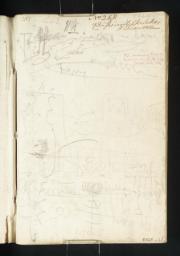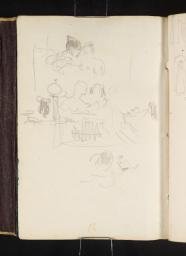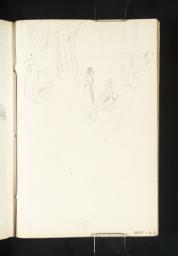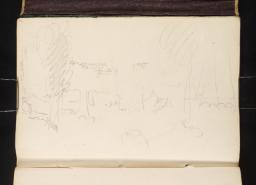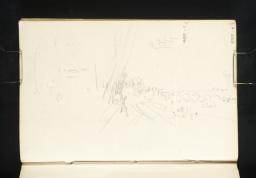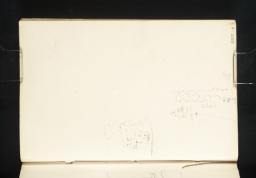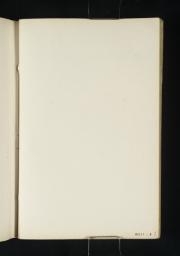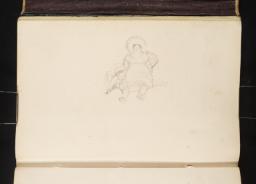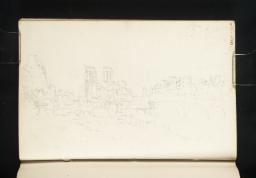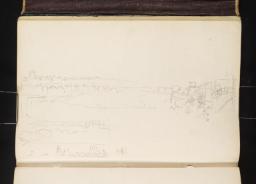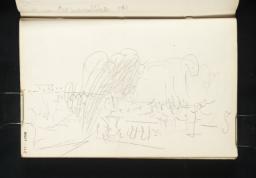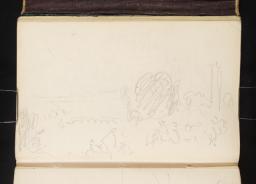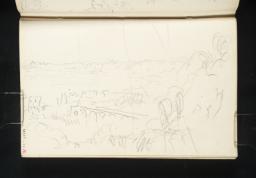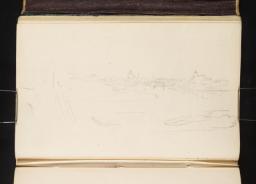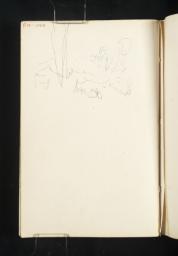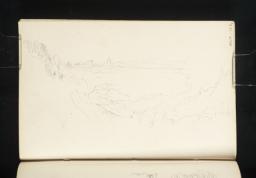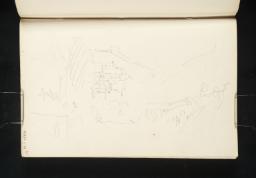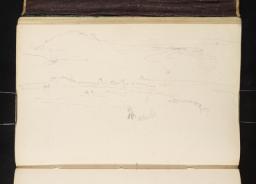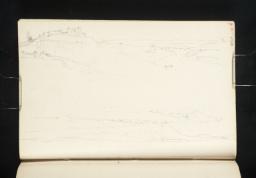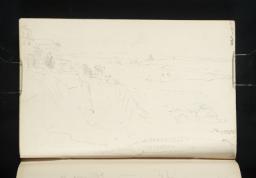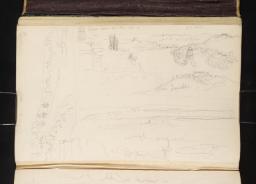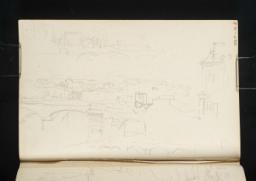Turner Bequest CCLIV 1–98a
Sketchbook with a front flap, bound in boards and buff calfskin
98 leaves and one paste-down of French white wove paper, with the edges washed yellow; page size 117 x 174 mm
Inscribed in black ‘CCLIV’ front cover top left
Stamped in black ‘CCLIV’ front cover top right
98 leaves and one paste-down of French white wove paper, with the edges washed yellow; page size 117 x 174 mm
Inscribed in black ‘CCLIV’ front cover top left
Stamped in black ‘CCLIV’ front cover top right
Exhibition history
References
Bound in soft calfskin covers, this pocket sketchbook contains a substantial number of the pencil drawings which Turner made as he journeyed through Normandy and Paris in the late summer and autumn of 1832. Broadly speaking, the first third of the sketchbook is taken up with scenes around Paris and the Île-de-France while the rest is concerned with the picturesque banks of the River Seine as it flows from Rouen to Le Havre. As laid out in the Introduction to this tour, the material gathered at these sites contributed substantially to two of the artist’s major illustrative projects around this time: a new edition of Walter Scott’s Life of Napoleon Buonaparte (1834–6) and the Seine volumes of Turner’s Annual Tour: Wanderings by the Loire and Seine (1833–5; later reissued as Rivers of France).1 The majority of pages have been worked up with the volume turned horizontally, for the most part to accommodate expansive landscape vistas. In some instances, the artist’s loose and rapid sketching technique resolves into careful architectural studies while, on other leaves, little is left behind but scant and indecipherable markings, as if the subject has been jotted down in transit. Contrast, for instance, folio 40 verso (D23960; Turner Bequest CCLIV 40a) with folio 13 recto (D23905; Turner Bequest CCLIV 13)
In 1973 art historian Gerald Finley confidently dated this sketchbook to the French tour of 1832 although it was not until Ian Warrell’s 1999 Turner on the Seine publication that this timeframe gained general acceptance.2 At that point, several of the monuments depicted at Paris’s Père-Lachaise Cemetery were found to have been of recent erection, and certainly post-dated Turner’s last known visit to the city in 1829.3 As well as shoring up the connection between the volume and the Napoleon and Annual Tour illustrations, this dating strongly suggests that the sketchbook’s foliation is misleading with regards to the sketches’ chronological sequence. It was formerly assumed that Turner first made use of the volume at Paris and gradually filled its pages on a return trip to the English Channel along the Seine.4 However, since Turner only agreed to illustrate the Scott text once he had arrived at in the French capital in 1832, an upstream course now seems more likely, with material first gathered in Normandy for the ongoing Annual Tour project until early September, followed by a Parisian stay documenting key Napoleonic landmarks until late October.5
With a view to satisfying the voracious English demand for Romantic and Antiquarian landscape imagery, Turner gathered a great deal of material relating to the remnants of Normandy’s medieval heyday.6 Typical subjects in the sketchbook are the region’s ruined fortresses and elaborate Gothic churches, sometimes rising above wooded escarpments and at other times making reflections in the sweeping curves of the Seine. Between Le Havre and Les Andelys, Turner’s itinerary generally follows the course of the river, although the presence of the inland towns of Montivilliers, Pontoise, and Gisors suggest a search for ideas that extended beyond the limits of the Annual Tour commission with its special emphasis on the riverbank. For each of the more frequently recurring sites in the volume, a key entry is selected under which relevant sketches are listed: Le Havre and Cap de la Hève, folio 48 recto (D23975; Turner Bequest CCLIV 48); Montivilliers, folio 96 recto (D24071; Turner Bequest CCLIV 96); Caudebec-en-Caux, folio 75 recto (D24029; Turner Bequest CCLIV 75); Jumièges, folio 71 recto (D24021; Turner Bequest CCLIV 71); Rouen, folio 60 recto (D23999; Turner Bequest CCLIV 60); Château Gaillard at Les Andelys, folio 51 verso (D23982; Turner Bequest CCLIV 51a); Gisors, folio 41 verso (D23962; Turner Bequest CCLIV 41a); Courcelles-lès-Gisors, folio 36 recto (D23951; Turner Bequest CCLIV 36); Pontoise, folio 33 recto (D23945; Turner Bequest CCLIV 33).
At Paris, Turner continued his study of the Seine, accumulating information on the bridges and quaysides which ultimately contributed to three engravings in the 1835 volume of the Annual Tour. The artist also made the seven-mile trip into the western outskirts of the city to document the hilly, riverside landscape at Saint-Cloud, where the atmosphere of carefree holiday-making was captured in a further three Annual Tour illustrations. The Château de Saint-Cloud, was also an important venue in the life of Napoleon, and the sketches made here eventually contributed to an elaborate depiction of its buildings and terraces for the Scott biography; see especially folio 17 verso (D23914; Turner Bequest CCLIV 17a). More specific to the Napoleonic commission were the multiple sketches of the Père-Lachaise Cemetery, which provided both a panoramic view across Paris and elaborate stone monuments to military heroes of the First Empire. In the resulting illustrative engraving, the tombs of André Massena, François Joseph Lefebvre, and Denis Decrès featured prominently; see Tate impression T04744. A full list of the studies taken here is included under the entry for folio 24 verso (D23928; Turner Bequest 24a). Several pages are also given over to depictions of the city’s grander streets and residences as the artist attempted to track down the former Emperor’s lodgings; see, for example, folio 30 verso (D23940; Turner Bequest CCLIV 30a). This search appears to have degenerated into something of a ‘hopeless’ wild goose chase, as a consequence of ‘every one thinking it in a different place’.7
W[illiam] G[eorge] Rawlinson, The Engraved Work of J.M.W. Turner, R.A., vol.II, London 1908, pp.289–92 nos.530–40.
Gerald Finley, ‘Two Turner Studies’: ‘A “New Route” in 1822: Turner’s Colours and Optics’; ‘Turner’s Illustrations to Napoleon’, Journal of the Warburg and Courtauld Institutes, vol.36, 1973, p.394.
For example, Maurice Guillaud, Nicholas Alfrey, Andrew Wilton and others, Turner en France: aquarelles, peintures, dessins, gravures, carnets de croquis / Turner in France: Watercolours, Paintings, Drawings, Engravings, Sketchbooks, exhibition catalogue, Centre Culturel du Marais, Paris 1981, p.329.
Technical notes
How to cite
John Chu, ‘Seine and Paris Sketchbook 1832’, sketchbook, July 2014, in David Blayney Brown (ed.), J.M.W. Turner: Sketchbooks, Drawings and Watercolours, Tate Research Publication, April 2015, https://www

